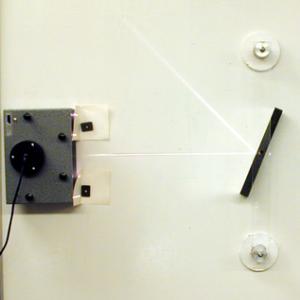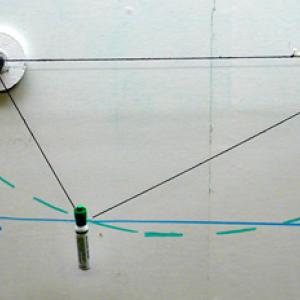College of Liberal Arts & Sciences
6A10.10 - Blackboard Optics - Straight Mirrors
Video Credit: Jonathan M. Sullivan-Wood
The blackboard optics unit is pretty self explanatory, however there is a pamphlet on its use with the unit and in the file. Do Not run the power supply for the light bulb over 12 volts.
We can also do a demo on the blackboard optics unit where we explain the situation of incident angle of light rays on a mirror. Draw a straight line near the bottom of the board to represent the mirror. Then use the ellipse maker apparatus to draw your arcs and show the angles. Dry erase markers are in the drawer on the B.B. Optics Unit.
- Refath Bari, "Simulating the Action Principle in Optics", TPT, Vol. 61, #3, March 2023, p. 212.
- Carl E. Mungan, Deducing the Law of Reflection From Fermat's Principle, "TPT, Vol. 60, #4, April 2022, p. 245.
- Shirish R. Pathare, Bhagyashri G. Latad, Rohan D. Lahane, Saurabhee S. Huli, "Why Is the Angle of Incidence Equal to the Angle of Reflection? An Activity", TPT, Vol. 59, #8, Nov. 2021, p. 650.
- Paul Hewitt, "Answer to March 2017 Figuring Physics", TPT, Vol. 55, #4, Apr. 2017, p. 253.
- Iain MacInnes and Andrew Donaldson, "More mirror magic", TPT, Vol. 55, #4, Apr. 2017, p. 235.
- Marshall Ellenstein, "Magic sunglasses", TPT, Vol. 55, #3, Mar. 2017, p. 187.
- Kjell Prytz, "The Atomic Origin of the Reflection Law", TPT, Vol. 54, #9, Dec. 2016, p. 535.
- Jair Lúcio Prados Ribeiro, "Reflections on a Disco Ball", TPT, Vol. 54, #9, Dec. 2016, p. 532.
- John Carlson, "The Signaling Mirror: A Lifesaving Application of Reflection and Refraction", TPT, Vol. 52, #6, Sept. 2014, p. 374.
- Ahmet Uysal, "Determining the Thickness and Refractive Index of a Mirror," TPT, Vol. 48, #9, Dec. 2010, p. 602.
- David R. Russell, "Alfresco Reflections", TPT, Vol. 48, #1, Jan. 2010, p. 74.
- Madhuri Bapat, "Using Ethnic Art to Emphasize Laws of Reflection", TPT, Vol. 47, #8, Nov. 2009, p. 542.
- Kreetha Kaewkhong, Narumon Emarat, Kwan Arayathanitkul, and Alex Mazzolini, "A Simple Apparatus for Demonstrating How Light Rays Emanate From a Point Source", TPT, Vol. 47, #4, Apr. 2009, p. 243.
- "Figuring Physics", TPT, Vol. 43, #3, Mar. 2005, p. 180.
- C. Criado and N. Alamo, "Optical Properties of the Conics Derived from an Elementary Kinematic Consideration", TPT, Vol. 42, #5, May 2004, p. 272.
- Jorge Sztrajman and Agustin Rela, "Optical Property of the Ellipse Derived from Energy Conservation", TPT, Vol. 41, #4, Apr. 2003, p. 208.
- Theodore H. Ansbacher, "Left-Right Semantics?", TPT, Vol. 30, #2, Feb. 1992, p. 70.
- Igal Galili, Sharon Bendall and Fred Goldberg, "Author's Response", TPT, Vol. 30, #2, Feb. 1992, p. 70.
- "Martin Gardner, "A Mirror Paradox", TPT, Vol. 30, #1, Jan. 1992, p. 27.
- Igal Galili, Fred Golberg, and Sharon Bendall, "Some Reflections on Plane Mirrors and Images", TPT, Vol. 29, #7, July 1991, p. 471.
- Lila M. Adair, "A Reflection on the Game of Tag", TPT, Vol. 27, #5, May 1989, p. 362.
- Jay S. Huebner, "Multiple Reflections from Common Mirrors", TPT, Vol. 25, #4, Apr. 1987, p. 233.
- "Erratum", TPT, Vol. 25, #3, Mar. 1987, p. 139.
- Danel Kaplan, "Plane Mirror Praise", TPT, Vol. 25, #4, Apr. 1987, p. 199.
- D. Easton, "On Reflections in Ponds", TPT, Vol. 25, #3, Mar. 1987, p. 150.
- "Figuring Physics", TPT, Vol. 25, #9, Dec. 1987, p. 582.
- Edwin R. Jones and R. D. Edge, "Optics of the Rear-View Mirror: A Laboratory Experiment", TPT, Vol. 24, #4, Apr. 1986, p. 221.
- "View It", TPT, Vol. 24, #7, Oct. 1986, p. 426.
- Fred M. Goldberg and Lillian C. McDermontt, "Student Difficulties in Understanding Image Formation by a Plane Mirror", TPT, Vol. 24, #7, Oct. 1986, p. 472.
- Jim Nelson, "Reflection on the Study of Flat Mirrors: Two Demonstrations", TPT, Vol. 22, #6, Sept. 1984, p. 388.
- Y. P. Hwu, "Experiments with Fermat's Principle", TPT, Vol. 16, #7, Oct. 1978, p. 481.
- Thomas B. Greenslade, Jr., "The Half-Length Mirror", TPT, Vol. 16, #6, Sept. 1978, p. 381.
- T.T. Crow, "A Simple Reflection Experiment", TPT, Vol. 11, #5, May 1973, p. 309, also A Potpourri of Physics Teaching Ideas - Optics and Waves, p. 179.
- "Christmas is a Time for Mysteries", TPT, Vol. 10, #9, Dec. 1972, p. 516.
- Marvin Ohriner, "Experimental Demonstration of Fermat's Principle", TPT, Vol. 3, #5, May 1965, p. 230.
- Thomas B. Greenslade, Jr., "The Half-Length Mirror", AJP, Vol. 92, #6, June 2024, p. 478.
- G.B. Frieedmann and H. S. Sandrhu, "Phase Changes on Reflection from a Metallic Surface", AJP, Vol. 56, #3, Mar. 1988, p. 270.
- A. J. de Witte, "Interference in Scattered Light", AJP, Vol. 35, #4, Apr. 1967, p. 301.
- J. H. Shaw, "Fermat's Principle and Geometrical Optics", AJP, Vol. 33, #1, Jan. 1965, p. 40.
- Barbara Goss Levi, "New Angles to Refraction and Reflection in Chiral Liquids", Physics Today, Vol. 59, #12, Dec. 2006, p. 22.
- Ob-8,11: Freier and Anderson, A Demonstration Handbook for Physics, File.
- Martin Gardner, "Another Mirror Paradox", Science Tricks, p. 68.
- David Kutliroff, "5, Play with Mirrors", 101 Classroom Demonstrations and Experiments For Teaching Physics, p. 27.
- J. C. Martinez-Antón, Edited by Karl Mamola, "A Technique for Making Brighter Rays", Apparatus for Teaching Physics, p. 217.
- C. Harvey Palmer, "Experiment A4: Demonstration of the Redirective Properties of Prisms and Plane Mirror Devices", Optics - Experiments and Demonstrations, John Hopkins Press, 1962.
- T. D. Rossing, C. J. Chiaverina, "3.1, Images Formed by Plane and Curved Mirrors", Light Science, Physics and Visual Arts, p. 51.
- Sara Stein, "Mirror, Mirror", The Science Book, p. 196.
- "Reflection and Refraction", Selective Experiments in Physics, CENCO, 1940.
- Julius Sumner Miller, Q7 & 8, A7 & 8, Millergrams I – Some Enchanting Questions for Enquiring Minds, p. 18 & 19 & 78.
- Julius Sumner Miller, Q17 & A17, Millergrams I – Some Enchanting Questions for Enquiring Minds, p. 22 & 82.
Disclaimer: These demonstrations are provided only for illustrative use by persons affiliated with The University of Iowa and only under the direction of a trained instructor or physicist. The University of Iowa is not responsible for demonstrations performed by those using their own equipment or who choose to use this reference material for their own purpose. The demonstrations included here are within the public domain and can be found in materials contained in libraries, bookstores, and through electronic sources. Performing all or any portion of any of these demonstrations, with or without revisions not depicted here entails inherent risks. These risks include, without limitation, bodily injury (and possibly death), including risks to health that may be temporary or permanent and that may exacerbate a pre-existing medical condition; and property loss or damage. Anyone performing any part of these demonstrations, even with revisions, knowingly and voluntarily assumes all risks associated with them.

